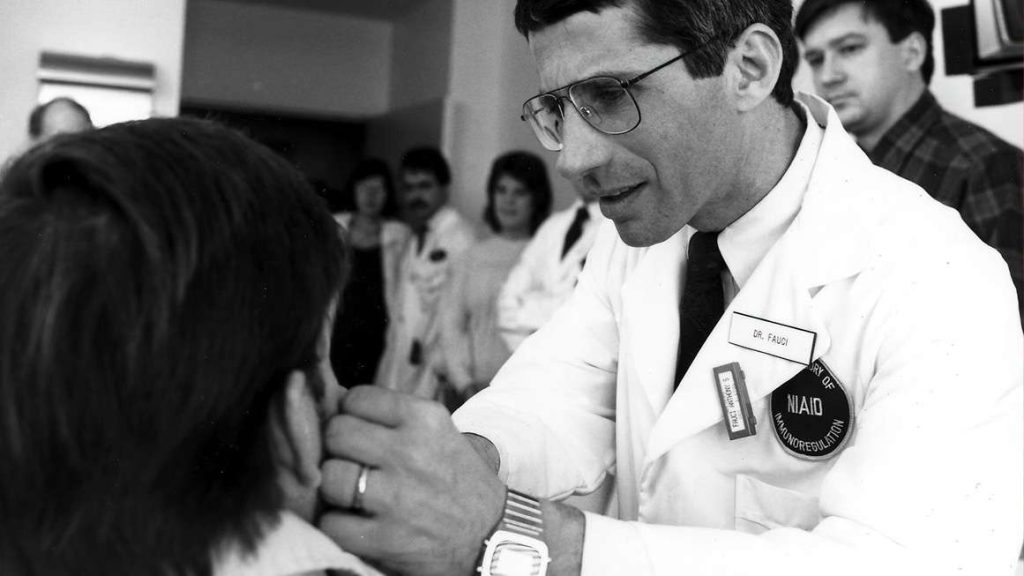On Call: A Doctor’s Journey in Public Service, by Anthony Fauci, Viking, 480 pages, $36
As a young medical student, I admired Tony Fauci. I bought and read Harrison’s Principles of Internal Medicine, a vital textbook that Fauci co-edited. In reading his new memoir, On Call, I remembered why I admired him. His concern about his patients’ plights, especially HIV patients, comes through clearly.
Unfortunately, Fauci’s memoir omits vital details about his failures as an administrator, an adviser to politicians, and a key figure in America’s public health response to infectious disease threats over the past 40 years. His life story is a Greek tragedy. Fauci’s evident intelligence and diligence are why the country and the world expected so much of him, but his hubris caused his failure as a public servant.
It is impossible to read Fauci’s memoir and not believe he was genuinely moved by the plight of AIDS patients. Since the first time he learned of the illness from a puzzling and alarming case report, his laudable ambition has been to conquer the disease with drugs and vaccines, cure every patient, and wipe the syndrome from the face of the earth. He is both sincere and correct when he writes that “history will judge us harshly if we don’t end HIV.”
When an aide in 1985 offered to quit when he contracted AIDS for fear of scandal at Fauci’s beloved National Institute of Allergy and Infectious Diseases (NIAID), Fauci hugged him, declaring “Jim, you crazy son of a bitch, there is no way in the world I would ever let you go.” This was Fauci at his best.
But Fauci paints an incomplete picture of his attitude toward AIDS patients in its early days. In 1983, in response to a case report of an infant with AIDS published in The Journal of the American Medical Association, Fauci told the press that AIDS might be spread by routine household contact. There was no good evidence then and is none now to suggest that HIV is transmitted that way. But Fauci’s statement, prominently echoed in the media, panicked the American people, almost certainly leading many to physically shun AIDS patients out of an unfounded fear of catching the disease.
Fauci does not address this incident, so one is left to speculate about why he was attracted to this theory. One possibility is that there was little political support for government spending on AIDS when the public thought it only affected gay men. As the public came to understand AIDS impacted broader populations, such as hemophiliacs and IV drug users, public support for funding HIV research expanded.
Fauci was tremendously successful in eventually building public support for government spending on treating and trying to prevent the spread of AIDS. Likely no other scientist in history moved more money and resources to accomplish a scientific and medical goal than Fauci, and his memoir proves he was highly skilled in managing bureaucracy and getting his way both from politicians and from an activist movement that was at first highly skeptical about him. (One prominent AIDS activist, playwright Larry Kramer, once called Fauci a murderer.)
Fauci’s response to activist criticism was to build relationships and use them as a tool to push for more government funding. Fauci’s activist allies seemed to understand the game, staging attacks on Fauci, both playing their part to gain more money for HIV research.
By contrast, his treatment of scientific critics is harsh, crossing lines that federal science bureaucrats should not cross. In 1991, when University of California, Berkeley, professor and wunderkind cancer biologist Peter Duesberg put forward a (false) hypothesis that the virus, HIV, is not the cause of AIDS, Fauci did everything in his power to destroy him. In his memoir, Fauci writes about debating Duesberg, writing papers, and giving talks to counter his ideas. But Fauci did more, isolating Duesberg, destroying his reputation in the press, and making him a pariah in the scientific community. Though Fauci was right and Duesberg wrong about the scientific question, the scientific community learned it was dangerous to cross Fauci.
Fauci’s HIV record is mixed. The great news is that, because of tremendous advances in treatment, a diagnosis of HIV is no longer the death sentence it was in the 1980s or 1990s. Fauci claims credit in his memoir, pointing out that the NIAID developed a clinical trial network that made it easier for researchers at pharmaceutical companies to conduct randomized studies of the effectiveness of HIV medications. But any competent National Institutes of Health (NIH) director would have directed NIAID resources this way. Furthermore, many in the HIV community have criticized Fauci for not using this network to test treatment ideas developed within the community—especially off-patent medications. Fauci is more reasonable when he takes credit for the 2003 creation of the President’s Emergency Plan for AIDS Relief program (PEPFAR), through which the U.S. sent effective HIV medications to several African nations.
Despite billions of dollars spent on the task, no one to date has produced an effective HIV vaccine or a definitive cure, and the virus remains a threat to the health and well-being of the world population. By Fauci’s own high standard, there is still a long way to go.
In the early days of the war on terror, Fauci became head of civilian biodefense, with the mandate to develop and stockpile countermeasures to biowarfare agents. This appointment made Fauci one of the most well-paid and powerful figures in the U.S. government. Fauci leveraged his deep knowledge of the federal bureaucracy, streamlining federal contracting rules to issue “sole source contracts” and “rapid research grants” to create constituencies of companies and scientists who depended on Fauci for their success.
In 2005, avian flu emerged and spread among birds, chickens, and livestock. Also spreading were worries that the virus could evolve to become more transmissible among human beings. Fauci deployed NIAID money to develop an avian flu vaccine, leading the government to stockpile tens of millions of ultimately unused and unnecessary doses.
At this point, virologists persuaded Fauci’s NIAID to support dangerous scientific lab experiments designed to make the avian flu virus more easily transmissible among humans.
In 2011, NIAID-funded scientists in Wisconsin and the Netherlands succeeded. They published their results in a prestigious scientific journal, so that anyone with the knowledge and resources could replicate their steps. They effectively weaponized the avian flu virus and shared the recipe with the world, with Fauci and his agency in full support.
The idea behind this gain-of-function research was that we would learn which pathogens might leap into human beings, and that knowing that would help scientists develop vaccines and treatments for these prospective possible pandemics. Fauci, writing to molecular biologists in 2012, downplayed the possibility that laboratory workers or scientists studying these dangerous pathogens might cause the pandemic they were working to prevent. He also argued that the risk of such an accident was worth it: “In an unlikely but conceivable turn of events, what if that scientist becomes infected with the virus, which leads to an outbreak and ultimately triggers a pandemic? Many ask reasonable questions: given the possibility of such a scenario—however remote—should the initial experiments have been performed and or published in the first place, and what were the processes involved in this decision? Scientists working in this field might say—as indeed I have said—that the benefits of such experiments and the resulting knowledge outweigh the risks. It is more likely that a pandemic would occur in nature, and the need to stay ahead of such a threat is a primary reason for performing an experiment that might appear to be risky.”
The NIH did pause funding gain-of-function work aimed at increasing germs’ pathogenicity. The pause didn’t last long, though. In the waning days of the Obama administration, the government implemented a bureaucratic process to permit NIH and NIAID to fund gain-of-function work again. Fauci played a pivotal behind-the-scenes role in reversing the pause, but his memoir provides almost no information about what he did. This is a gaping, telling hole, given subsequent history with COVID-19.
Among the projects Fauci and the NIAID funded during these years was research to identify coronaviruses in the wild and bring them into laboratories to study their potential for causing a human pandemic. The work encompassed laboratories worldwide. Fauci’s organization funded an American outfit, EcoHealth Alliance, which worked with scientists at the Wuhan Institute of Virology.
In his memoir, Fauci goes out of his way to deny that any NIH money went to any activities that might have led to the creation of the SARS-CoV-2 virus that causes COVID. When Sen. Rand Paul (R–Ky.) in July 2021 confronted Fauci with the possibility that Fauci’s NIAID had funded this work, Fauci resorted to cheap debate tactics to obfuscate his and the NIH’s responsibility in supporting this work. It is undeniable that Fauci championed pathogen enhancement for a decade or more.
While the molecular biological and genetic evidence for a laboratory origin of SARS-CoV-2 is strong, many virologists disagree. (Their entire field would come under a cloud were it true, and many virologists’ careers have been generously supported by Fauci’s NIAID.) The debate on this topic rages on. A review of Fauci’s memoir is not the place to settle the dispute.
But in judging Fauci’s record as a scientist and a bureaucrat, it’s worth knowing that in 2020, Fauci and his boss, Francis Collins, failed to empanel public discussions and debates on this vital topic. Instead, they created an environment where any scientist voicing the lab leak hypothesis came under a cloud of suspicion, accused of advancing unfounded conspiracy theories. As with Duesberg, Fauci sought to destroy the careers of dissenting scientists.
In his memoir, Fauci writes of a “right-wing…smear campaign [that] soon boiled over into conspiracy theories.” He asserts, “One of the most appalling examples of this was the allegation, without a shred of evidence, that an NIAID grant to the EcoHealth Alliance with a sub-grant to the Wuhan Institute of Virology in China funded research that caused the COVID pandemic.”
But in congressional testimony in 2024, Fauci denied that he had called the idea of a lab leak a conspiracy theory: “Actually, I’ve also been very, very clear and said multiple times that I don’t think the ‘concept’ of there being a lab leak is inherently a conspiracy theory.”
This self-serving denial makes a lawyerly distinction between the possibility of a lab origin of the COVID pandemic and the NIH’s funding of EcoHealth Alliance to work with the Wuhan Institute of Virology on coronaviruses. These are neither “right-wing” nor “conspiracy theories,” and the likelihood of a connection between the two is, for good reason, the subject of active bipartisan congressional investigation.
Fauci was quick to gather all the glory of administrative achievements like PEPFAR to himself while decrying any possibility of blame for the origin of COVID. But if he is responsible for the consequences of one (the millions of Africans saved because of PEPFAR), he is responsible for the consequences of the other. This includes the tens of millions who have died due to the COVID pandemic and the catastrophically harmful lockdowns used to manage it. This is Fauci at his worst.
By any measure, the American COVID response was a catastrophic failure. More than 1.2 million deaths have been attributed to COVID itself, and deaths from all causes have stayed high long after the number of COVID deaths themselves diminished. In many states, particularly blue states, children were kept out of school for a year and a half or longer, with devastating effects on their learning and future health and prosperity.
Coercive policy regarding COVID vaccination, recommended by Fauci on the false premise that vaccinated people could not get or spread the virus, collapsed public trust in other vaccines and led the media and public health officials to gaslight individuals who had suffered legitimate vaccine injuries. To pay for the lockdowns recommended by Fauci, the U.S. government spent trillions of dollars, causing high unemployment in the most locked-down states and a hangover of higher prices for consumer goods that continues to this day. Who is to blame?
Fauci served as a key adviser to both President Donald Trump and President Joe Biden, and was a central figure on Trump’s COVID task force that determined federal policy. If Fauci has no responsibility for the outcomes of the pandemic, nobody does. Yet in his memoir’s chapters on COVID, he simultaneously takes credit for advising leaders while disclaiming any responsibility for policy failures.
Fauci implausibly writes that he “was not locking down the country” and “had no power to control anything.” These statements are belied by Fauci’s own bragging about his influence on a host of policy responses, including convincing Trump to lock the country down in March 2020 and extend the lockdown in April.
He discusses the extended closure of schools, now almost universally seen as a bad idea, in the passive voice, as if the virus caused the school closures on its own. In congressional testimony in 2020, Fauci exaggerated the harm to children from getting infected with COVID, instilling fear in parents that their kids might suffer from a rare complication of COVID infection if they sent them to school. It is impossible not to recall Fauci exaggerating the risk of children contracting HIV from casual contact.
In May 2020, Fauci said that schools should reopen, conditional on “the landscape of infection with regard to testing.” But he also recommended six-foot social distancing, based on no evidence—a policy that made it nearly impossible to open schools. Fauci opposed churches holding services and mass, even outdoors, despite the lack of evidence that the disease spread there. His memoir provides little detail about the scientific data he relied on to support these policies.
All this background makes his discussion of the Great Barrington Declaration all the more galling. The Declaration is a short policy document I wrote along with Martin Kulldorff (then of Harvard University) and Sunetra Gupta (of the University of Oxford) in October 2020. Motivated by recognizing that the lethality and hospitalization risk from COVID was 1,000 times lower in younger populations than in older, the document had two recommendations: (1) focused protection of vulnerable older populations, and (2) lifting lockdowns and reopening schools. It balanced the harms of the lockdowns against the risks of the disease in a way that recognized that COVID was not the only threat to human well-being and that the lockdowns themselves did considerable harm.
Fauci denigrates the Great Barrington Declaration as being filled with “fake signatures,” though FOIAed emails from the era make it clear he knew tens of thousands of prominent scientists, doctors, and epidemiologists had co-signed it. In his memoir, he repeats a propaganda talking point about the Declaration, falsely claiming the document called for letting the virus “rip.” In reality, it called for better protection of vulnerable elderly people.
Fauci asserted it was impossible to “sequester to protect the vulnerable” while simultaneously calling for the whole world to sequester for his lockdowns. His rhetoric about the Great Barrington Declaration poisoned the well of scientific consideration of our ideas. With brass-knuckle tactics, he won the policy fight, and many states locked down in late 2020 and into 2021.
The virus spread anyway.
Fauci does not mention the success of Swedish COVID policy, which eschewed lockdowns and instead—after some early errors—focused on protection of the vulnerable. Swedish all-cause excess death rates in the COVID era are among the lowest in Europe and much lower than American all-cause excess deaths. The Swedish health authorities never recommended closing schools for children 16 and under, and Swedish children, unlike American children, have no learning loss.
If lockdowns were necessary to protect the population, as Fauci claims, Swedish outcomes should have been worse than American ones. Even within the United States, locked-down California had worse all-cause excess deaths numbers and economic outcomes than Florida, which opened in the summer of 2020. It is shocking that Fauci still does not seem to know these facts.
Near the end of his memoir, Fauci writes that by March 2022, he knew “there would not be a clear end to the pandemic”; the world would need to learn to “live indefinitely with COVID.” He reasons that “perhaps the vaccine and prior infection had created a degree of background immunity.” This is as close as he comes in the book to admitting error.
A part of me cannot help but admire Fauci, but the extent of damage caused by his hubris gets in the way. He once told an interviewer, “If you are trying to get at me as a public health official and a scientist, you’re really attacking not only Dr. Anthony Fauci, you’re attacking science….Science and the truth are being attacked.” Despite his career accomplishments, no one should give any man, much less Fauci, credit for being the embodiment of science itself.
If Fauci’s goal in writing this memoir is to guide how historians write about him toward the positive, I do not think he succeeded. He will be remembered as a consequential figure for his contributions to the American approach to the HIV and COVID pandemics. But he will also be remembered as a cautionary tale of what can happen when too much power is invested in a single person for far too long.
The post Anthony Fauci, the Man Who Thought He Was Science appeared first on Reason.com.







